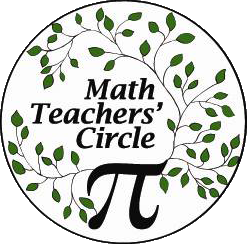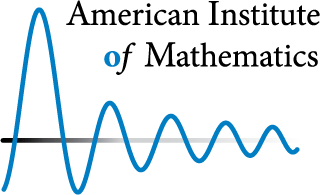
Image via Michael Ortiz
A Problem Fit for a Princess
Tracing the 2,000-year history of a fractal that inspired one MTC’s logo.
Christopher Goff
Like the MTCircular? Subscribe to our free semi-annual magazine.
When we first formed the San Joaquin Math Teachers’ Circle, we decided to design a logo that prominently featured circles. We ended up basing our logo on an Apollonian gasket, a fractal generated from circles. Little did we know that this logo would take us on a journey, starting in ancient Greece, passing through seventeenth century Bohemia, moving through twentieth century fractals, and ultimately forming the focus of one of our problem-solving sessions.
Warm-Up: Mutually Tangent Circles
I like to start this session with a warm-up problem about mutually tangent circles (circles that touch at exactly one point): Find a circle that is tangent to all three circles below. How many such circles can you find?

Teachers usually find a small circle between all three given circles. They also find a big circle that circumscribes all three. In the figure below, those two new circles are drawn in red. It’s harder to find the three circles in green, as well as the three big blue circles that “contain” two circles each.
In total, there are eight circles tangent to all three given circles. Through discussion, we distinguish two types of circles: circles that are externally tangent to each other (i.e., the centers of the two tangent circles lie on opposite sides of the mutual tangent line at the point of tangency) or internally tangent (the centers lie on the same side of this line). Another way to see this is to look at whether the circles are curving in opposite directions when they touch (externally tangent) or in the same direction (internally tangent). These concepts will play a role later.
Now, we can classify the eight circles we found based on whether they are externally or internally tangent to the three given circles.
It turns out that our warm-up problem is over 2,000 years old. It was originally posed by Apollonius of Perga, a Greek mathematician who lived in the 200s BCE and was a contemporary of Archimedes. Apollonius wrote a book, Tangencies, in which he supposedly stated and solved problems about different geometric objects that were tangent to each other, including our warm-up problem. I say “supposedly” because, unfortunately, the original work is lost. We know about the book from other sources, such as Pappus of Alexandria, who was born over 500 years after Apollonius, and who mentioned Tangencies in his own work.
The Logo: Notice and Wonder
At this point, I ask the teachers to take a minute to look at the logo for the San Joaquin MTC. Then, together, we discuss the things we notice and wonder about the logo. This usually brings up some very good questions.
Usually, teachers wonder: what do the numbers mean? They notice that the larger circles contain smaller numbers. Occasionally, they notice a pattern in the numbers along one “arm”: 2, 3, 6, 11, 18, 27, 38, ….
Are there other patterns here? Will the numbers in the circles always be integers?
A Princess’s Question
Before we attempt to answer all of these questions, let’s take another historical detour.
Princess Elisabeth of Bohemia (1618-1680) corresponded with many great intellectuals of her time, and her letters with René Descartes (1596-1650) are especially rich. The two often discussed his philosophical ideas in addition to mathematics; he even dedicated his book Principia Philosophiae to her.
Perhaps to test the capabilities of his analytic geometric techniques, which were relatively new at the time, Princess Elisabeth asked Descartes to solve the following problem: Given three circles, find the circle that is externally tangent to all three. In other words, find the center and the radius of the circle that is “between” the three circles.
At this point, we take time in our Math Teachers’ Circle to try to solve the problem posed by Princess Elisabeth, at least in the case illustrated by our logo, where the three shaded green circles are mutually tangent.
After discussing some strategies and partial solutions, we take a look at Descartes’ solution. It is unlikely that someone will find as nice a solution as the one Descartes found. I can say that because I had great difficulty working out the algebra involved, even when trying to follow along with Descartes! However, it turns out that when the three given circles are mutually tangent to each other, the solution can be written relatively simply, especially if we utilize the concept of curvature.
A Formula of Curvatures
The curvature k of a circle is defined as the reciprocal of its radius r. That is, k = 1/r. Using this notation, if there are four mutually tangent circles with curvatures k1, k2, k3, and k4, then the curvatures satisfy the following equation:
If we expand our definition of curvature to include positive and negative values, then we can extend the formula to apply to situations when circles are internally tangent as well as externally tangent. We just need to include a relative minus sign between the curvatures of internally tangent circles. We can even apply the formula if one of the circles has an infinite radius – that is, if it’s really a straight line with a curvature of 0.
Given the information that our logo lives inside a large circle of radius 1, at this point, someone usually notices that the numbers inside the circles refer to their curvatures. If we look at the three green circles, which have curvatures 2, 2, and 3, then we can find the curvature k of a circle that is tangent to these three mutually tangent circles.
2(17 + k2) = (7 + k)2
k2 – 14k – 15 = 0
(k – 15)(k + 1) = 0
And so the curvature of the circle we are looking for is either 15 or –1. If you look at the logo, you can see that the circle of curvature 15 is nestled between circles of curvature 2, 2, and 3. You can also see that the big circle has curvature 1, and is internally tangent to these three circles. Hence its curvature is notated as –1.
The teachers can now verify many of the curvatures indicated in the San Joaquin MTC logo. They can even create their own similar figure starting with different curvatures. However, given the quadratic nature of the governing formula, one will not always obtain nice integer curvatures. As a result, I usually offer a few “nice” starting options for teachers. Many can be found online.
Extensions
This kind of a shape is a fractal pattern called an Apollonian Gasket, honoring Apollonius and his Tangencies. In addition to fractals, other related concepts include Soddy circles and Ford circles. Prominent number theorists have studied some of the properties of the numbers that appear as curvatures in a given gasket pattern. Some have even generalized this formula to higher dimensions.
Our logo took us on quite a journey!
Resources
- “Circles of Apollonius” Math Teachers’ Circle session materials:
- Descartes, Rene. (1664). Principia philosophiae (Principles of philosophy). Paris, France: World Digital Library.
- Bogomolny, Alexander. Ford’s touching circles. Interactive Mathematics Miscellany and Puzzles. Accessed 24 August 2017.
This article originally appeared in the Summer/Autumn 2017 MTCircular.
 |
Christopher Goff, a co-founder of the San Joaquin County MTC, is a Professor of Mathematics at the University of the Pacific. |
MORE FROM THE
SUMMER/AUTUMN 2017 MTCIRCULAR

|
What’s in a Logo?A sampling of logos from MTCs across the country
|

|
Polygons and PrejudiceIntroducing social issues through math
|
 |
Daydreams in MusicPatterns in musical scales
|

|
Problem PosingA framework to empower participants
|
 |
MTCs featured in KQED MindShiftKQED News reports that Math Teachers’ Circles help teachers bring a sense of wonder and discovery back to math classrooms
|

|
MTCs Advocating for Math in ESSA PlansUndertaking a collaborative effort to promote the advancement of mathematics education
|

|
Adams, Ghosh Hajra, Manes Win AwardsThree MTC leaders recognized for teaching excellence and community engagement
|
 |
A Note from AIM: #playwithmathCelebrating math as social, creative, and energizing
|
 |
Dispatches from the CirclesLocal updates from across the country
|

|
Global Math WeekComing in October!
|





